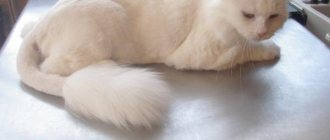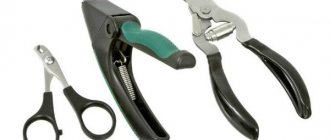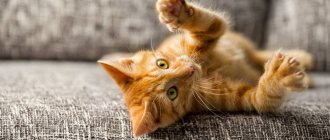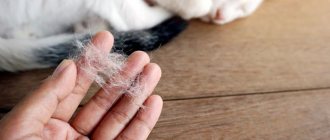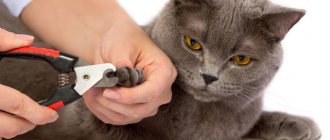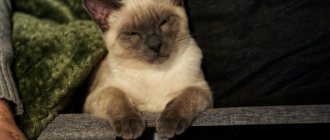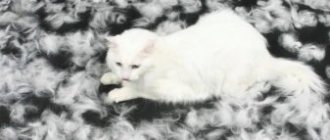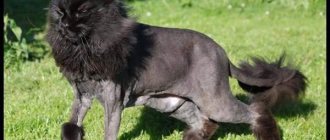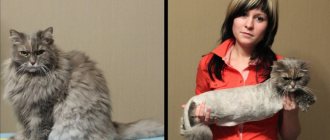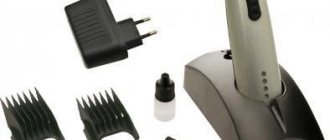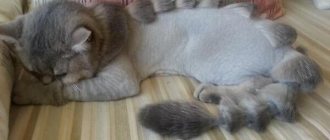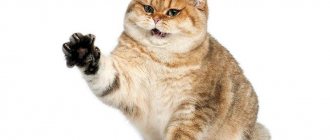Compared to dogs, cats require less maintenance to keep them hygienically clean. Many veterinarians believe that cats do not need partial or complete hair trimming, since such a procedure can cause more harm than good. And they recommend cutting your pet’s hair only when necessary.
Why shouldn't you cut cats?
Cats do not need a haircut: their fur creates a protective function, regulating body temperature and saving the paw pads from various injuries. These animals “wash themselves” by licking themselves and their relatives; combing itself with claws, thereby preventing the formation of tangles.
If the owner believes that his pet is suffering from the summer heat, then there is no need to rush into cutting it. It is enough to provide the cat with a cool place, for example in the bathroom, under an air conditioner, and you should also make sure that there are several bowls of water in the house.
Grooming at home
If you don't want to go to the salon, call a specialist at home. He will do everything quickly and at a reasonable price. If you take part in exhibitions with your pet, the cats are groomed by professionals.
Benefits of grooming at home:
- Familiar home environment. In addition, traveling to and from the salon is stressful for some cats.
- Convenience - you don’t need to go to the salon, choose a time and wait for your turn.
- Rapidity. A hairdresser will need much less time to groom a cat than the owner.
- Availability of necessary tools. Special scissors, brushes and clippers will allow the master to easily deal with long hair.
- Safety. The groomer will not damage the cat's delicate skin, as he has safe tools and knows how to trim correctly.
- No anesthesia. Anesthesia is contraindicated for cats: it will be difficult for the animal to recover from it, and for old pets it can be fatal.
- Prices are lower than in the salon.
Reasons why it is not advisable to cut your cat's hair
The opinions of veterinarians vary, but on some points they are unanimous:
The process of shearing is a strong shock and stress for the animal. As a result, a decrease in the body's immune defense may occur.- Due to frequent haircuts, the coat becomes thinner, which contributes to the formation of tangles more frequently.
- Constant haircuts can change the color, structure of the coat and undercoat. It becomes dull and brittle.
- The cat's skin becomes drier, often causes itching and leads to scratching, which will then have to be treated for a long time.
Veterinarians strongly do not recommend cutting cats with short-haired breeds or those with medium-length hair:
- Burmese,
- Maine Coon,
- Norwegian forest cats,
- redgolls,
- Siberian cats,
- Turkish Angoras.
Their fur has a special structure and differs significantly from other species: it consists of two layers and has different hair lengths. A hairless cat can easily become overheated or hypothermic.
How to carry out the procedure
It is important to carry out all manipulations as accurately as possible so as not to injure the animal.
It’s not always possible to completely trim an animal right away—don’t get angry: even though the procedure is carried out in several stages, all participants will remain unharmed.
After grooming, the cat should be washed and dried with a hairdryer. Although, to avoid unnecessary stress, you can simply wipe your pet with a damp cloth to remove any clippings and stuck hairs.
In the cold season, the cut miracle must be equipped with a comfortable indoor microclimate without drafts and the possibility of hypothermia.
© shutterstock
When is a cat's haircut necessary?
There are situations when a four-legged friend really needs to cut his fur coat. Let's look at the main ones:
When a cat has a large number of mats of different sizes. Combing the animal in such cases may not always give results, since the tangles very quickly form dense wool balls, which are easier to cut out. In addition to being unsightly, tangles cause discomfort and health problems for your pet. By tightening the skin, they interfere with blood flow and cause itching. After all, by their nature, cats are very clean; they will try to get rid of the formed tangles on their own, scratching and gnawing out the lumps. But this is dangerous for the pet - he may accidentally swallow a hairball, which can block the passage in the digestive tract or cause severe vomiting.- Skin disease. It can be recognized by the appearance of weeping ulcers on the skin. The thick coat will make it difficult to treat with medications and will not provide adequate ventilation.
- Long molting. It can be caused by various reasons from skin problems to metabolic disorders. It is worth consulting a doctor in a timely manner.
- One of the family members has a wool allergy. But this method of getting rid of wool in the house is ineffective. After cutting, the amount of hair will decrease in volume, but if a person has an acute allergic reaction to wool, then the number of hairs on the pet’s body does not matter. We will have to look for other ways to combat allergies.
There are some cats that physically cannot take care of themselves. This is mainly due to age. Their fur will look dirty and unkempt, so it's best to keep it trimmed.
Sequencing:
- Initially, you should shorten your cat's claws. For this, manicure scissors are usually used: firstly, this tool can be found in every home, and secondly, high-quality scissors will help you deal with claws without unnecessary problems; If you wish, you can purchase a special device at a pet store - a nail clipper, which is easy to use, and its cost is quite affordable.
- Before you start trimming the nails, you need to disinfect the tool, usually using alcohol. Next, you need to take your pet’s paw in your hand and lightly press on the pad, after which the cat will release its claws, at this moment, without removing your fingers from the pad, begin the procedure of cutting the claws; To complete the procedure, it is recommended to use a nail file to file off the sharp ends.
- For the first time, it is better to trim a cat at home, with the help of a person who will help you hold the animal correctly, and, as a rule, it is much easier to cope with the procedure together. So, the partner, having laid the cat on its side, must hold its limbs.
- If the animal begins to behave quite aggressively, it is better to use a plastic collar.
- Next, they trim the cat with a clipper, starting from the sides, the main thing is not to worry and try not to shake your hands, because an animal that behaved calmly, sensing the owner’s excitement, can show both anxiety and aggressiveness, and then you will no longer be able to do the procedure at home.
- After the sides, the back and belly are trimmed; Particular attention is paid to the abdominal area where the nipples are located.
- It is possible to cut the hair both in the direction of hair growth and against it.
- If the haircut is carried out with an electric clipper, you need to remember that the nozzle must be at least 3 mm.
- In order for everything to go without injury to the animal, you should trim the resulting lumps on the cat with scissors during the procedure, since using a clipper at home this will be impossible and quite unpleasant for the pet itself.
- During grooming, the animal's skin must be stretched to avoid cuts.
- When cutting hair at home, the head, paws at the ends and tail are usually left untouched; this haircut will look like a lion's.
- If necessary, you can use thinning scissors to go through the untrimmed wool.
- When the whole procedure has come to an end, the cat is washed with clean water, or bathed with shampoo and dried with a hairdryer.
It is possible to cut the hair both in the direction of hair growth and against it.
[custom_ads_shortcode2]
Types of haircuts for cats
A special hygienic haircut is carried out no more than twice a year, so as not to damage the structure of the coat and skin. If the cat must participate in an exhibition, the last haircut is done no later than six months before the event.
Trimming is usually done with a special clipper, leaving a hair length of approximately 3-3.5 millimeters. After this procedure, the animal’s skin becomes soft and velvety to the touch.
It is not advisable to cut your cat’s hair on your own, since a high-quality result will require many special tools:
- different types of hairdressing scissors,
- hair clipper,
- set of combs
It is forbidden to cut cats completely, that is, bald. This will disrupt the heat exchange process and can soon cause serious skin irritation.
Therefore, when grooming an animal, it is necessary to leave at least a minimum length of hair to protect it from sunburn or hypothermia.
Description and photo
Sometimes, for stylish reasons, show cats are given a model look by experimenting with types of trimming. There are many options for such haircuts now, but let’s look at the most popular ones:
- "Puma" - short hair on the body, and the head looks like a lion's mane;
- “Dragon” is a curly haircut in which hairs are left along the line of the spine, and various figures or symbols are cut from them;
- “Golfies” - hair is removed only on the upper part of the paws.
What to do if you accidentally hurt your pet?
Even with the most careful procedure, an unpleasant situation is possible when you injure the animal. You need to prepare for this and always have the necessary disinfectants on hand (peroxide, brilliant green, iodine), as well as cotton wool. It is necessary to treat not the wound itself with a disinfectant, but the skin around it. Treat the cut site in such a way as to stop the bleeding. Calm and caress the animal; in this case, you can prepare some kind of treat that will distract the pet.
There is no need to be nervous or lose your composure. Your anxiety will be transmitted to the animal, and the cat will begin to panic. Moreover, it is unacceptable to shout at a cat or use physical methods of influence. The procedure can be carried out further only when the animal has completely calmed down and allows manipulation to continue.
Carrying out a hygienic haircut for your furry pet yourself is a completely doable task. Hygienic care is necessary to ensure that your pet looks neat, well-groomed and does not suffer from the heat in the summer. But, if a fluffy cat is preparing to go out into the world, for example, to an exhibition, it is better to contact a grooming salon or veterinary clinic. Professionals will do the job more efficiently and decoratively. The only thing you need to pay attention to is that during the procedure, veterinary clinics usually use light anesthesia or give sedatives. It's not entirely harmless. If your furry pet behaves calmly, you can refuse to use these products.
Do you like the article? 77
How to trim or shave a pet?
There is nothing complicated in grooming a cat if you follow the rules and sequence of actions:
- Nail trimming. The claws are trimmed with special tweezers, having been disinfected in advance. When you lightly press the paw pads, the hidden claws will extend. The owner will need to trim only the very ends.
- To begin with, you may need an assistant - he will hold the animal, preventing it from running away. Some cats react aggressively to the appearance of grooming tools. For the safety of the owner and the pet itself, it is worth putting a special plastic collar on the animal that does not allow it to bite.
The cat is laid on its side, its paws are fixed. To cut, you need a machine or scissors. The machine will help avoid damage to the skin, but can be frightening with its buzzing.- First, the hair is removed from the sides, and then moved to the back and belly. You need to remove hair as it grows, and in the opposite direction. Hair that remains long after cutting with a clipper can be trimmed with nail scissors. There must be a tassel on the tail.
- At the end of the procedure, the pet must be bathed with a special shampoo for cats, and then dried with a towel. If your pet is not afraid of a hair dryer, it can also be used for drying. But veterinarians still recommend going to a professional groomer. Because he is a competent and qualified specialist. He will do the haircut quickly and without any damage.
When performing a haircut of any shape, there are certain rules:
- in order not to damage the mustache and hair in the ears, the hair on the head, muzzle and in the auricle is not cut;
- “socks” are left on the lower part of the legs;
- the hairs of the front legs under the elbow and from the hind legs under the jumping joint are not removed;
- the hair is left at the end of the tail (a section at least 3 cm long must be left uncut).
Tools and accessories
To groom a cat at home, you need to be patient and prepare the necessary equipment in advance. The less fuss and emotions there are, the calmer, faster and without incidents everything will go. So what might you need?
- assistant,
- special trimmer for cats (regular and for hard-to-reach places),
- rounded scissors with blunt ends, it is best to take surgical ones,
- In case of possible injury, prepare peroxide, cotton wool, and brilliant green.
The requirements for the trimmer are:
- quality and reliability;
- power of at least 45 watts. It is especially important to observe this point in relation to Persians, exotics and other owners of luxurious hair with thick undercoat;
- for other breeds, less powerful devices are also suitable;
- sharp blades that actually cut rather than tear out fur;
- the length of the blade is from 2 to 3 cm, otherwise you can accidentally injure the skin, especially if the haircut is carried out by an inexperienced user;
- the device must operate from the network, which guarantees its stable operation without interruption or loss of power;
- It is better if the motor is rotary rather than vibrating. Although this is not important, especially if the cat is cut from time to time.
Instead of an electric unit, you can use the most ordinary mechanical machine. It has a number of advantages:
- lower price,
- absence of unpleasant noise, and therefore the animal will be less nervous,
There are also some disadvantages: the hairstyle may turn out to be asymmetrical, and the process will be lengthy.
In principle, you can trim a cat’s hair at home with simple scissors, especially if you only need to cut off tangles or shape individual areas of the body.
Benefits and harms
Like any grooming procedure, cat trimming has its positive and negative properties. Let's look at them in detail.
Pros:
Relief from heat and health problems. There is a very common stereotype that representatives of long-haired breeds suffer from heat, especially during the hot season.- It is necessary to cut a cat if for some reason (for example, due to age) it cannot care for its fur, and you do not have the opportunity to constantly care for it. All this can soon lead to a visit to the veterinarian, and in worst cases, to surgery.
- Caring for a cat can also save the lives of owners who suffer from allergies or asthma. It will help eliminate the factor leading to suffocation and exacerbation of the disease.
Minuses:
- Many cats have a negative attitude towards haircuts. It, like bathing, causes discomfort and stress for the cat. After this, the pet may be depressed, and due to resentment, it may even become offended and ignore the owner. Particularly proud pets can leave a “surprise” in their owner’s slippers in retaliation for an attack on their fur coat.
- After cutting, the cats' hairs become a little smaller. Even the color of the animal may become lighter. If the coat is shortened too much, the animal will feel unwell and may experience dryness and loss of elasticity.
- There are cases when in some areas of the skin the hair does not grow back after cutting. This means that alopecia appears. This is caused by hypothermia and improper hair growth. This condition is mainly characteristic of dogs, but there have been cases when it also occurred in cats. If baldness began to appear even before the cut, do not try to solve the problem: here you need to contact a veterinarian.
How does haircut affect animals?
Is it possible to cut a cat's hair without causing any changes, and how will cutting it at home affect the pet's behavior?
Haircut significantly affects hair growth. In almost all long-haired breeds, the color of the coat changes, acquiring a darker or lighter shade. It happens that haircut significantly affects the growth of fur, sometimes this process accelerates, and in some cases, on the contrary, it becomes slower, and in rare cases it stops growth completely.
[custom_ads_shortcode3]
Which cats are contraindicated for trimming?
Experts do not recommend cutting smooth-haired cats. Their fur does not form tangles, and its complete absence will increase the risk of injury to the skin. It is contraindicated to trim cats if:
- The color of the animal is color point or tipping. After regrowth, the coat may change, and the cat will lose its unique color.
- It is contraindicated for the animal to be nervous. Some cats have medical conditions that make stress life-threatening. Grooming is not a natural process for a pet, so in most cases it makes him worry.
- The previous procedure had a negative impact on the pet's health.
- The cat lives in an area with high solar activity and spends a lot of time outside. By trimming a pet, the owner deprives him of protection from the negative effects of ultraviolet radiation.
[custom_ads_shortcode3]
Preparing your pet for the procedure
Preparing the cat for the procedure:
- Bathing. It is carried out with a mild shampoo and conditioner to facilitate combing and eliminate the electrification effect. Held a few days before the event.
- Trimming claws. It is necessary to cut off the sharp ends so that the cat does not scratch the performer during the procedure.
- Removing hair around the nipples. The coat should be carefully trimmed with sharp scissors or shaved. Manipulation will prevent injury to sensitive areas during cutting.
- Trimming mats. It will not be possible to trim the stray clumps with a clipper, so you need to remove them before starting the procedure.
- Introducing the animal to the tool. You need to move a short distance from your pet and turn on the machine. He will understand that the sound is not dangerous and will behave calmer.
[custom_ads_shortcode2]
Precautions when cutting
When choosing a hair clipper at home, preference should be given to models that operate on mains power. You should not purchase them with a small blade to avoid injury; the minimum length is 0.5 mm.
It is important for the owner not to worry during the haircut, otherwise his anxiety will be passed on to his pet.
Avoid overheating the machine.
For long-haired cats, using scissors is ineffective.
To ensure normal thermoregulation of the animal, it is recommended to cut the hair not too short.
Source
What to do if the cat resists and does not allow its fur to be cut?
Some owners use sedatives and sleeping pills to subdue animals. However, experts consider sleeping pills extremely dangerous for cats. Medicines can cause allergies, heart pathologies, and liver diseases in cats.
Medicines should only be used as a last resort if the haircut is carried out for the purpose of further treatment. The drugs are administered after preliminary consultation with a veterinarian. To calm an excited cat without anesthesia, the following measures are used:
- Applying a binder to the withers. The clamp is perceived by the animal as a mother's grip. The pet instinctively calms down.
- Application of a plastic collar. The device will protect the owner and helper from bites.
- Breaks between haircuts. After pausing the procedure, you should take the pet in your arms, calm it down and give it a small treat.
- Using a mechanical silent machine. However, using a manual trimmer will increase the time of the procedure and reduce its quality.
- Distraction with your favorite toy.
Under no circumstances should you:
- raise your voice;
- scold and beat your pet;
- allow other pets near the cat;
- tie paws.
[custom_ads_shortcode1]
